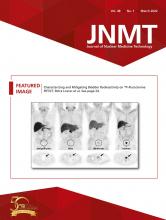Article Figures & Data
Tables
Characteristic Test value P Caffeine consumers Non–caffeine consumers Mean age t = 1.299 0.1970 63.39 (12.34) 58.00 (17.77) β-blocker use χ2 = 0.785 0.3757 41% 27% Diabetes χ2 = 0.323 0.5701 37% 45% Sex χ2 = 3.404 0.0650 57% M 27% M Mean body weight (kg) t = 1.264 0.2093 85.30 (19.03) 92.99 (19.23) Mean body mass index t = 2.041 0.0439 29.40 (6.62) 33.69 (6.21) Coronary artery disease χ2 = 0.068 0.7944 31% 27% Hypertension χ2 = 0.157 0.6916 87% 91% Hyperlipidemia χ2 = 3.562 0.0591 62% 91% Smoker χ2 = 0.764 0.3821 20% 9% Data in parentheses are SDs.
Symptom P Caffeine consumers Non–caffeine consumers All symptoms 0.9579 Aminophylline use 0.0371 18% 45% Palpitations 0.2053 2% 9% Shortness of breath 0.4972 23% 30% Flushing 0.9241 10% 9% Chest pain 0.0013 10% 45% Headache 0.2713 14% 27% Nausea or vomiting 0.8218 16% 18% Dizziness 0.1018 20% 0% Feeling hot 0.5387 3% 0% Abdominal pain 0.2718 10% 0% Back pain 0.7253 1% 0% Dysgeusia 0.2053 2% 9% Parameter P Caffeine consumers Non–caffeine consumers Arrhythmia 0.8995 34% 36% Resting HR (bpm) 0.0497 68.76 (12.32) 76.82 (15.71) Peak HR (bpm) 0.0314 96.52 (16.72) 108.00 (13.93) HR response (bpm) 0.4587 27.77 (13.80) 31.18 (18.73) BP response 0.3659 31% hyper/22% hypo 20% hyper/10% hypo Atrial fibrillation 0.3553 3% 9% Hypotension 0.5387 97% 91% Systolic BP response (mm Hg) 0.7671 10.12 (23.10) 7.90 (14.37) Diastolic BP response (mm Hg) 0.0468 0.24 (10.46) −7.20 (16.06) Rest systolic BP (mm Hg) 0.4453 134.72 (19.89) 129.70 (17.19) Rest diastolic BP (mm Hg) 0.7210 77.54 (13.14) 79.10 (11.88) Peak systolic BP (mm Hg) 0.3517 144.84 (27.28) 136.91 (18.82) Peak diastolic BP (mm Hg) 0.2438 77.79 (14.72) 72.27 (14.83) HR = heart rate; bpm = beats per minute; BP = blood pressure; hyper = hypertensive blood pressure response; hypo = hypotensive blood pressure response.
Data in parentheses are SD.







